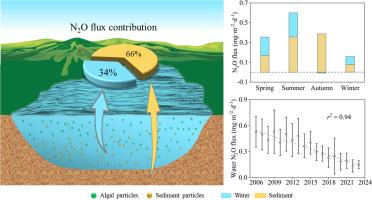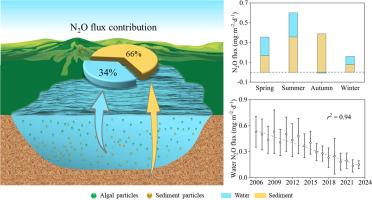中国超过三分之一的N2O排放来自大的、浅的和富营养化的太湖
IF 12.4
1区 环境科学与生态学
Q1 ENGINEERING, ENVIRONMENTAL
引用次数: 0
摘要
在浅湖中,沉积物通常被认为是氮循环和氧化亚氮(N2O)排放的热点,因为它们含有丰富的营养物质和微生物。然而,在大型浅富营养化湖泊中,严重的沉积物再悬浮和藻类增殖导致水中颗粒浓度高,这可能承载活跃的氮循环并显著影响N2O排放。然而,水运N2O排放的贡献及其潜在机制仍不清楚。为此,本研究对中国太湖水体N2O通量进行了研究,量化了其对总排放的贡献,并利用实时定量聚合酶链反应阐明了相关的微生物机制。结果表明:太湖水体N2O通量对总排放贡献显著,年平均贡献34.1%,春、冬季贡献超过50%;相反,在秋季,水充当了N2O的水槽。在水体中检测到多种硝化和反硝化微生物,它们调节着N2O排放的源汇动态和强度。2006 - 2023年,太湖水体N2O总排放量为5382.7 Tg,随时间变化呈下降趋势。在追踪大型、浅层、富营养化湖泊的N₂O排放并制定减缓战略时,必须考虑水柱的贡献,而不是将来源仅仅归因于沉积物。本文章由计算机程序翻译,如有差异,请以英文原文为准。


Over one-third of N2O emissions originate from water in large, shallow and eutrophic Taihu Lake, China
In shallow lakes, sediments are often considered hotspots for nitrogen cycling and nitrous oxide (N2O) emissions due to their abundant nutrients and microorganisms. However, in large, shallow eutrophic lakes, severe sediment resuspension and algal proliferation lead to high concentrations of particles in the water, which may host active nitrogen cycling and significantly influence N2O emissions. Nevertheless, the contribution of waterborne N2O emissions and the underlying mechanism remain unclear. To explore it, this study investigated N2O flux from Taihu Lake water, China, quantified its contribution to total emissions, and elucidated the associated microbial mechanisms using real-time quantitative polymerase chain reaction. The results revealed that N2O flux from Taihu Lake water significantly contributed to total emissions, accounting for an annual average of 34.1 %, with contributions exceeding 50 % in spring and winter. In contrast, during autumn, the water served as a sink for N2O. A variety of nitrifying and denitrifying microorganisms were detected in the water, which regulate the source-sink dynamics and intensity of N2O emissions. From 2006 to 2023, the total N2O emissions from Taihu Lake water amounted to 5382.7 Tg, exhibiting a declining trend over time. When tracing N₂O emissions and developing mitigation strategies for large, shallow, eutrophic lakes, it is essential to consider the contribution of the water column rather than attributing the sources solely to sediments.
求助全文
通过发布文献求助,成功后即可免费获取论文全文。
去求助
来源期刊

Water Research
环境科学-工程:环境
CiteScore
20.80
自引率
9.40%
发文量
1307
审稿时长
38 days
期刊介绍:
Water Research, along with its open access companion journal Water Research X, serves as a platform for publishing original research papers covering various aspects of the science and technology related to the anthropogenic water cycle, water quality, and its management worldwide. The audience targeted by the journal comprises biologists, chemical engineers, chemists, civil engineers, environmental engineers, limnologists, and microbiologists. The scope of the journal include:
•Treatment processes for water and wastewaters (municipal, agricultural, industrial, and on-site treatment), including resource recovery and residuals management;
•Urban hydrology including sewer systems, stormwater management, and green infrastructure;
•Drinking water treatment and distribution;
•Potable and non-potable water reuse;
•Sanitation, public health, and risk assessment;
•Anaerobic digestion, solid and hazardous waste management, including source characterization and the effects and control of leachates and gaseous emissions;
•Contaminants (chemical, microbial, anthropogenic particles such as nanoparticles or microplastics) and related water quality sensing, monitoring, fate, and assessment;
•Anthropogenic impacts on inland, tidal, coastal and urban waters, focusing on surface and ground waters, and point and non-point sources of pollution;
•Environmental restoration, linked to surface water, groundwater and groundwater remediation;
•Analysis of the interfaces between sediments and water, and between water and atmosphere, focusing specifically on anthropogenic impacts;
•Mathematical modelling, systems analysis, machine learning, and beneficial use of big data related to the anthropogenic water cycle;
•Socio-economic, policy, and regulations studies.
 求助内容:
求助内容: 应助结果提醒方式:
应助结果提醒方式:


